2007 SUBARU TRIBECA brake fluid
[x] Cancel search: brake fluidPage 122 of 377
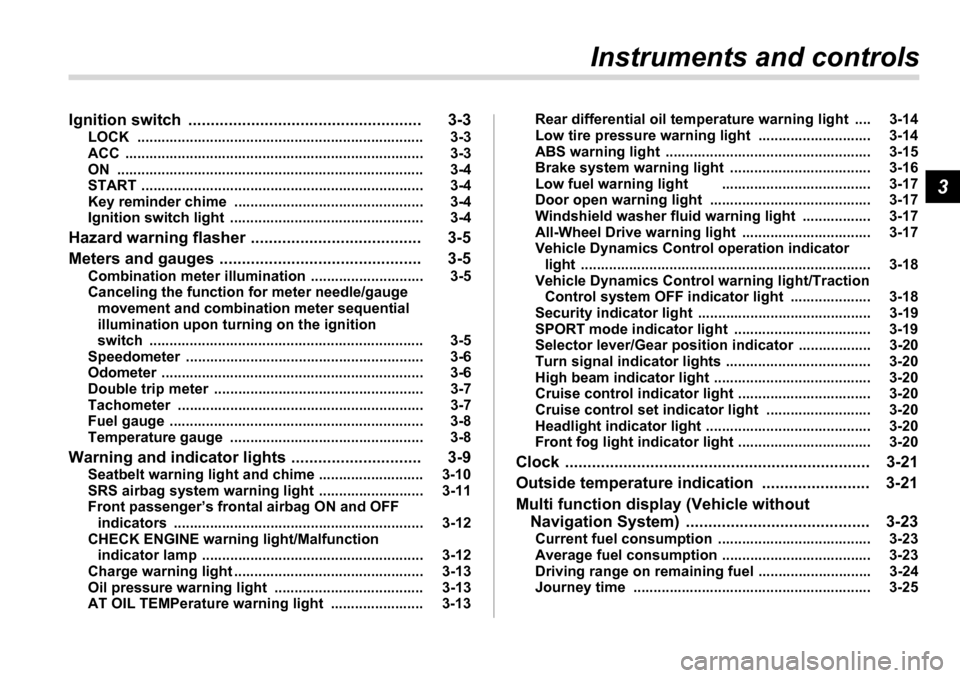
3
Instruments and controls
Ignition switch .................................................... 3-3 LOCK ....................................................................... 3-3
ACC .......................................................................... 3-3
ON ............................................................................ 3-4
START ...................................................................... 3-4
Key reminder chime ............................................... 3-4
Ignition switch light ................................................ 3-4
Hazard warning flasher ...................................... 3-5
Meters and gauges ............................................. 3-5 Combination meter illumination ............................ 3-5
Canceling the function for meter needle/gauge movement and combination meter sequential
illumination upon turning on the ignition
switch .................................................................... 3-5
Speedometer ........................................................... 3-6
Odometer ................................................................. 3-6
Double trip meter .................................................... 3-7
Tachometer ............................................................. 3-7
Fuel gauge ............................................................... 3-8
Temperature gauge ................................................ 3-8
Warning and indicator lights ............................. 3-9 Seatbelt warning light and chime .......................... 3-10
SRS airbag system warning light .......................... 3-11
Front passenger’s frontal airbag ON and OFF indicators .............................................................. 3-12
CHECK ENGINE warning light/Malfunction
indicator lamp ....................................................... 3-12
Charge warning light ............................................... 3-13
Oil pressure warning light ..................................... 3-13
AT OIL TEMPerature warning light ....................... 3-13 Rear differential oil temperature warning light .... 3-14
Low tire pressure warning light ............................ 3-14
ABS warning light ................................................... 3-15
Brake system warning light ................................... 3-16
Low fuel warning light ..................................... 3-17
Door open warning light ........................................ 3-17
Windshield washer fluid warning light ................. 3-17
All-Wheel Drive warning light ................................ 3-17
Vehicle Dynamics Control operation indicator
light ........................................................................ 3-18
Vehicle Dynamics Control warning light/Traction Control system OFF indicator light .................... 3-18
Security indicator light ........................................... 3-19
SPORT mode indicator light .................................. 3-19
Selector lever/Gear position indicator .................. 3-20
Turn signal indicator lights .................................... 3-20
High beam indicator light ....................................... 3-20
Cruise control indicator light ................................. 3-20
Cruise control set indicator light .......................... 3-20
Headlight indicator light ......................................... 3-20
Front fog light indicator light ................................. 3-20
Clock .................................................................... 3-21
Outside temperature indication ........................ 3-21
Multi function display (Vehicle without Navigation System) ......................................... 3-23Current fuel consumption ...................................... 3-23
Average fuel consumption ..................................... 3-23
Driving range on remaining fuel ............................ 3-24
Journey time ........................................................... 3-25
Page 137 of 377
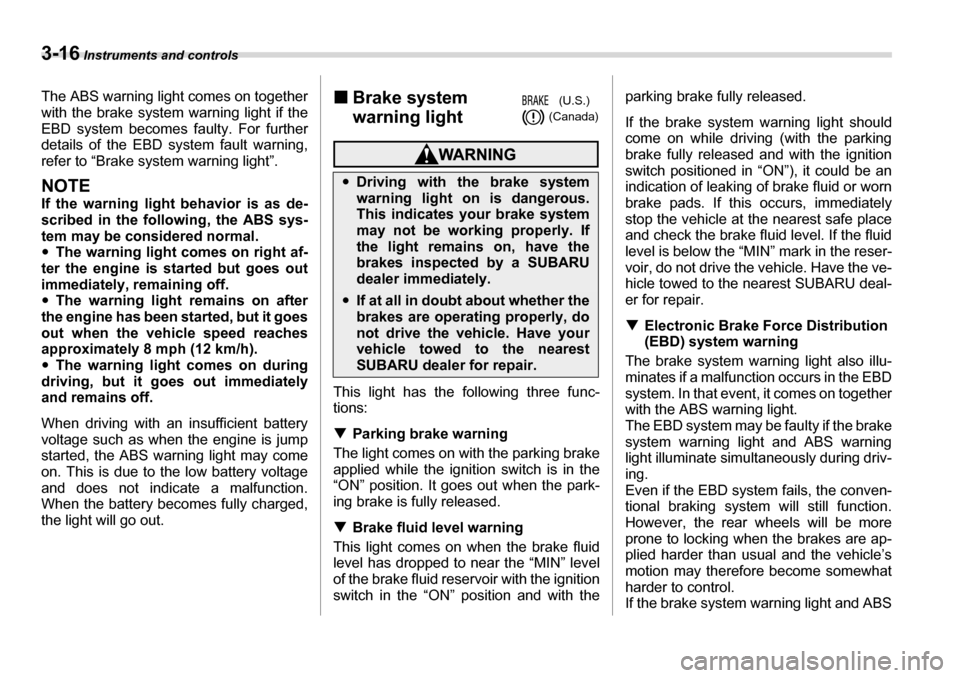
3-16 Instruments and controls
The ABS warning light comes on together with the brake system warning light if the
EBD system becomes faulty. For further
details of the EBD system fault warning,
refer to “Brake system warning light”.
NOTE
If the warning light behavior is as de-
scribed in the following, the ABS sys-
tem may be considered normal.�yThe warning light comes on right af-
ter the engine is started but goes out
immediately, remaining off.�y The warning light remains on after
the engine has been started, but it goes
out when the vehicle speed reaches
approximately 8 mph (12 km/h). �y The warning light comes on during
driving, but it goes out immediately
and remains off.
When driving with an insufficient battery
voltage such as when the engine is jumpstarted, the ABS warning light may come
on. This is due to the low battery voltage
and does not indicate a malfunction.
When the battery becomes fully charged,
the light will go out. �„
Brake system
warning light
This light has the following three func-
tions: �TParking brake warning
The light comes on with the parking brake
applied while the ignition switch is in the
“ON” position. It goes out when the park-
ing brake is fully released. �T Brake fluid level warning
This light comes on when the brake fluid
level has dropped to near the “MIN” level
of the brake fluid reservoir with the ignition
switch in the “ON” position and with the parking brake fully released. If the brake system warning light should
come on while driving (with the parking
brake fully released and with the ignition
switch positioned in “ON”), it could be an
indication of leaking of brake fluid or worn
brake pads. If this occurs, immediately
stop the vehicle at the nearest safe place
and check the brake fluid level. If the fluid
level is below the “MIN” mark in the reser-
voir, do not drive the vehicle. Have the ve-
hicle towed to the nearest SUBARU deal-
er for repair. �T
Electronic Brake Force Distribution
(EBD) system warning
The brake system warning light also illu-
minates if a malfunction occurs in the EBD
system. In that event, it comes on together
with the ABS warning light.
The EBD system may be faulty if the brake
system warning light and ABS warning
light illuminate simultaneously during driv-
ing.
Even if the EBD system fails, the conven-
tional braking system will still function.
However, the rear wheels will be more
prone to locking when the brakes are ap-
plied harder than usual and the vehicle’s
motion may therefore become somewhat
harder to control. If the brake system warning light and ABS
�y Driving with the brake system
warning light on is dangerous.
This indicates your brake system
may not be working properly. If
the light remains on, have the
brakes inspected by a SUBARU
dealer immediately.
�yIf at all in doubt about whether the
brakes are operating properly, do
not drive the vehicle. Have your
vehicle towed to the nearest
SUBARU dealer for repair.
(U.S.) (Canada)
Page 138 of 377
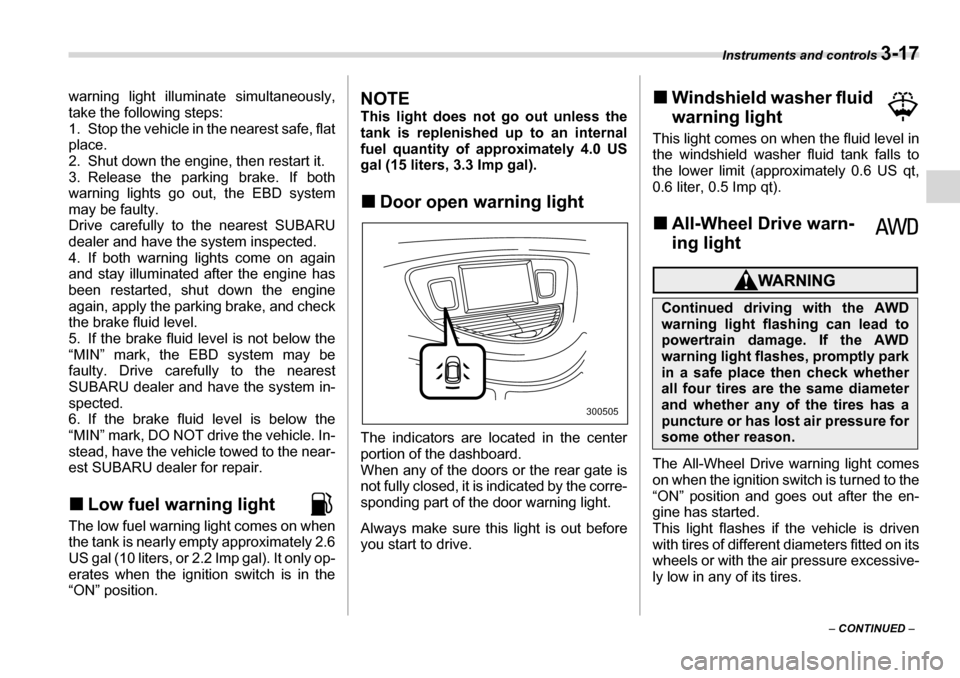
Instruments and controls 3-17
– CONTINUED –
warning light illuminate simultaneously,
take the following steps:
1. Stop the vehicle in the nearest safe, flat
place.
2. Shut down the engine, then restart it.
3. Release the parking brake. If both
warning lights go out, the EBD system
may be faulty.
Drive carefully to the nearest SUBARU
dealer and have the system inspected.
4. If both warning lights come on again
and stay illuminated after the engine has
been restarted, shut down the engine
again, apply the parking brake, and check
the brake fluid level.
5. If the brake fluid level is not below the
“MIN” mark, the EBD system may be
faulty. Drive carefully to the nearest
SUBARU dealer and have the system in-
spected.
6. If the brake fluid level is below the
“MIN” mark, DO NOT drive the vehicle. In-
stead, have the vehicle towed to the near-
est SUBARU dealer for repair. �„
Low fuel warning light
The low fuel warning light comes on when
the tank is nearly empty approximately 2.6
US gal (10 liters, or 2.2 Imp gal). It only op-
erates when the ignition switch is in the
“ON” position.
NOTE
This light does not go out unless the
tank is replenished up to an internal
fuel quantity of approximately 4.0 US
gal (15 liters, 3.3 Imp gal). �„ Door open warning light
The indicators are located in the center
portion of the dashboard.
When any of the doors or the rear gate is
not fully closed, it is indicated by the corre-
sponding part of the door warning light.
Always make sure this light is out before
you start to drive. �„
Windshield washer fluid
warning light
This light comes on when the fluid level in
the windshield washer fluid tank falls to
the lower limit (approximately 0.6 US qt,
0.6 liter, 0.5 Imp qt). �„ All-Wheel Drive warn-
ing light
The All-Wheel Drive warning light comes
on when the ignition switch is turned to the
“ON” position and goes out after the en-
gine has started.
This light flashes if the vehicle is driven
with tires of different diameters fitted on its
wheels or with the air pressure excessive-
ly low in any of its tires.
300505
Continued driving with the AWD
warning light flashing can lead to
powertrain damage. If the AWD
warning light flashes, promptly park
in a safe place then check whether
all four tires are the same diameter
and whether any of the tires has a
puncture or has lost air pressure for
some other reason.
Page 221 of 377
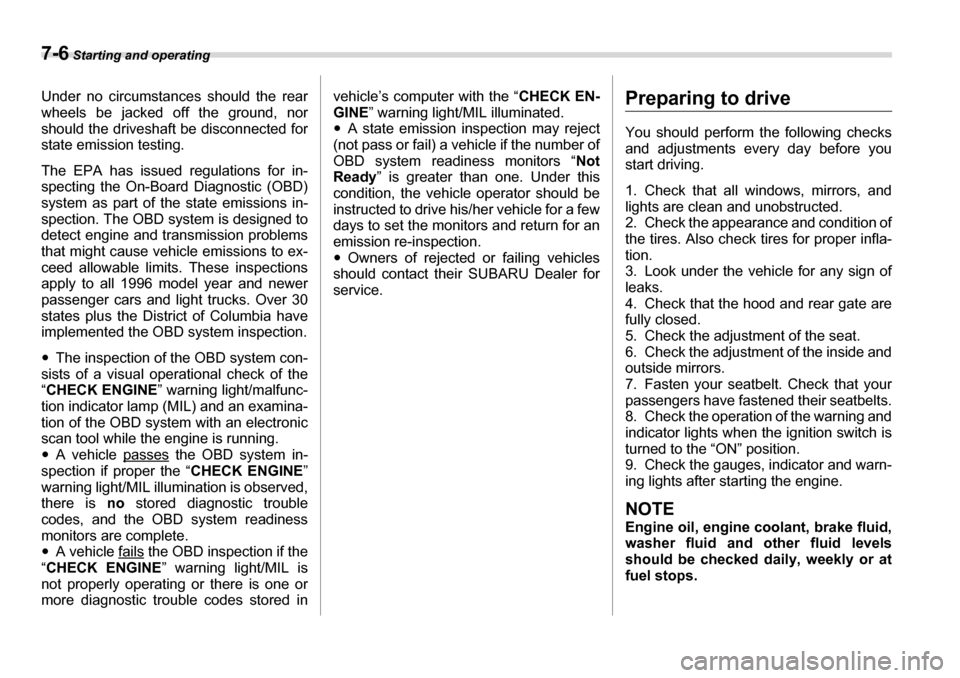
7-6 Starting and operating
Under no circumstances should the rear
wheels be jacked off the ground, nor
should the driveshaft be disconnected for
state emission testing. The EPA has issued regulations for in-
specting the On-Board Diagnostic (OBD)
system as part of the state emissions in-
spection. The OBD system is designed to
detect engine and transmission problems
that might cause vehicle emissions to ex-
ceed allowable limits. These inspections
apply to all 1996 model year and newer
passenger cars and light trucks. Over 30
states plus the District of Columbia have
implemented the OBD system inspection. �yThe inspection of the OBD system con-
sists of a visual operational check of the “ CHECK ENGINE ” warning light/malfunc-
tion indicator lamp (MIL) and an examina-
tion of the OBD system with an electronic
scan tool while the engine is running. �y A vehicle passes
the OBD system in-
spection if proper the “ CHECK ENGINE”
warning light/MIL illumination is observed,
there is no stored diagnostic trouble
codes, and the OBD system readiness
monitors are complete. �y A vehicle fails
the OBD inspection if the
“ CHECK ENGINE ” warning light/MIL is
not properly operating or there is one or
more diagnostic trouble codes stored in vehicle’s computer with the “
CHECK EN-
GINE ” warning light/MIL illuminated.
�y A state emission inspection may reject
(not pass or fail) a vehicle if the number of
OBD system readiness monitors “ Not
Ready ” is greater than one. Under this
condition, the vehicle operator should be
instructed to drive his/her vehicle for a few
days to set the monitors and return for an
emission re-inspection. �y Owners of rejected or failing vehicles
should contact their SUBARU Dealer for service.
Preparing to drive
You should perform the following checks
and adjustments every day before you
start driving.
1. Check that all windows, mirrors, and
lights are clean and unobstructed.
2. Check the appearance and condition of
the tires. Also check tires for proper infla-
tion.
3. Look under the vehicle for any sign of
leaks.
4. Check that the hood and rear gate are
fully closed.
5. Check the adjustment of the seat.
6. Check the adjustment of the inside and outside mirrors.
7. Fasten your seatbelt. Check that your
passengers have fastened their seatbelts.
8. Check the operation of the warning and
indicator lights when the ignition switch is
turned to the “ON” position.
9. Check the gauges, indicator and warn-
ing lights after starting the engine.
NOTE
Engine oil, engine coolant, brake fluid,
washer fluid and other fluid levels
should be checked daily, weekly or at
fuel stops.
Page 223 of 377
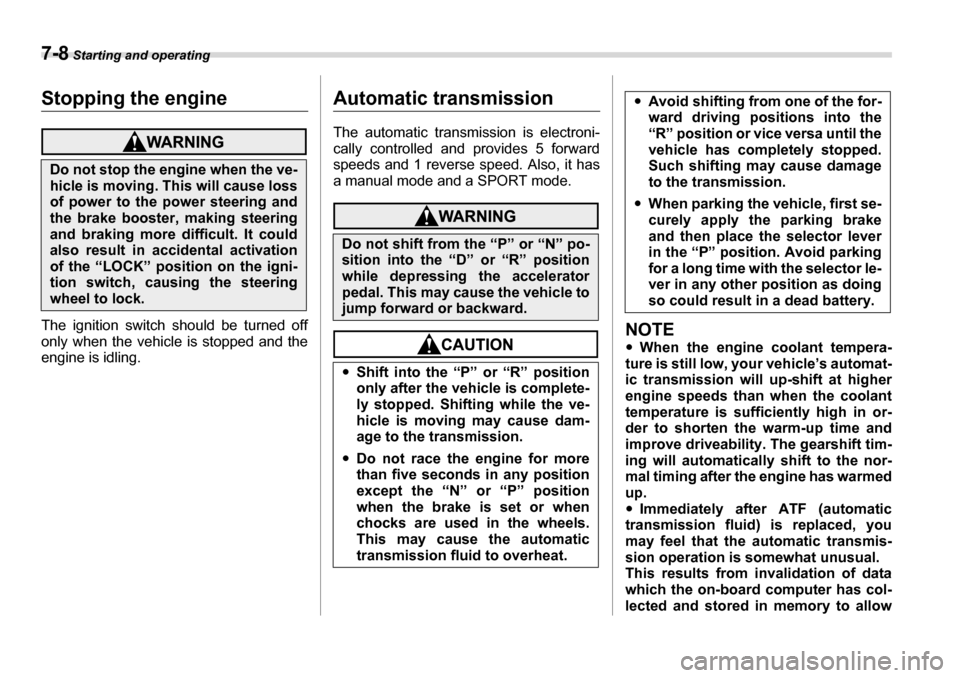
7-8 Starting and operating
Stopping the engine
The ignition switch should be turned off
only when the vehicle is stopped and the
engine is idling.
Automatic transmission
The automatic transmission is electroni-
cally controlled and provides 5 forward
speeds and 1 reverse speed. Also, it has
a manual mode and a SPORT mode.
NOTE �yWhen the engine coolant tempera-
ture is still low, your vehicle’s automat-
ic transmission will up-shift at higher
engine speeds than when the coolant
temperature is sufficiently high in or-
der to shorten the warm-up time and
improve driveability. The gearshift tim-
ing will automatically shift to the nor-
mal timing after the engine has warmed
up.�y Immediately after ATF (automatic
transmission fluid) is replaced, you
may feel that the automatic transmis-
sion operation is somewhat unusual.
This results from invalidation of data
which the on-board computer has col-
lected and stored in memory to allow
Do not stop the engine when the ve-
hicle is moving. This will cause loss
of power to the power steering and
the brake booster, making steering
and braking more difficult. It could
also result in accidental activation
of the “LOCK” position on the igni-
tion switch, causing the steering
wheel to lock.
Do not shift from the “P” or “N” po-
sition into the “D” or “R” position
while depressing the accelerator
pedal. This may cause the vehicle to
jump forward or backward. �y Shift into the “P” or “R” position
only after the vehicle is complete-
ly stopped. Shifting while the ve-
hicle is moving may cause dam-
age to the transmission.
�y Do not race the engine for more
than five seconds in any position
except the “N” or “P” position
when the brake is set or when
chocks are used in the wheels.
This may cause the automatic
transmission fluid to overheat.
�yAvoid shifting from one of the for-
ward driving positions into the
“R” position or vice versa until the
vehicle has completely stopped.
Such shifting may cause damage
to the transmission.
�y When parking the vehicle, first se-
curely apply the parking brake
and then place the selector lever
in the “P” position. Avoid parking
for a long time with the selector le-
ver in any other position as doing
so could result in a dead battery.
Page 230 of 377
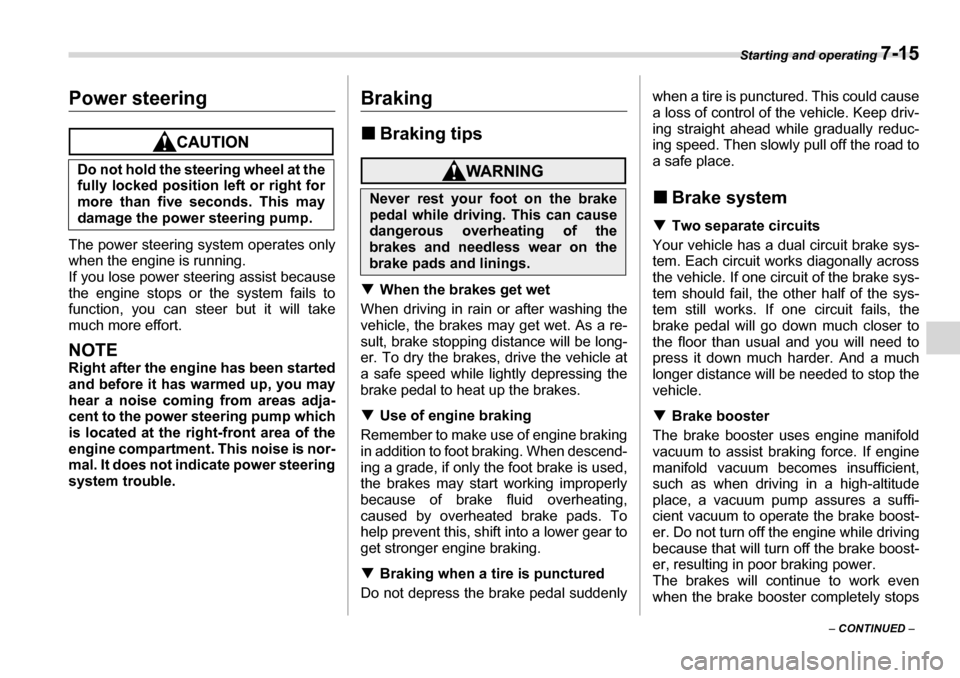
Starting and operating 7-15
– CONTINUED –
Power steering
The power steering system operates only
when the engine is running.
If you lose power steering assist because
the engine stops or the system fails to
function, you can steer but it will take
much more effort.
NOTE
Right after the engine has been started
and before it has warmed up, you may
hear a noise coming from areas adja-
cent to the power steering pump whichis located at the right-front area of the
engine compartment. This noise is nor-
mal. It does not indicate power steering
system trouble.
Braking �„Braking tips
�TWhen the brakes get wet
When driving in rain or after washing the
vehicle, the brakes may get wet. As a re-
sult, brake stopping distance will be long-
er. To dry the brakes, drive the vehicle at
a safe speed while lightly depressing the
brake pedal to heat up the brakes. �T Use of engine braking
Remember to make use of engine braking
in addition to foot braking. When descend-
ing a grade, if only the foot brake is used,
the brakes may start working improperly
because of brake fluid overheating,
caused by overheated brake pads. To
help prevent this, shift into a lower gear to
get stronger engine braking. �T Braking when a tire is punctured
Do not depress the brake pedal suddenly when a tire is punctured. This could cause
a loss of control of the vehicle. Keep driv-
ing straight ahead while gradually reduc-
ing speed. Then slowly pull off the road to
a safe place. �„
Brake system
�T Two separate circuits
Your vehicle has a dual circuit brake sys-
tem. Each circuit works diagonally across
the vehicle. If one circuit of the brake sys-
tem should fail, the other half of the sys-
tem still works. If one circuit fails, the
brake pedal will go down much closer to
the floor than usual and you will need to
press it down much harder. And a much
longer distance will be needed to stop the vehicle. �T Brake booster
The brake booster uses engine manifold
vacuum to assist braking force. If engine
manifold vacuum becomes insufficient,
such as when driving in a high-altitude
place, a vacuum pump assures a suffi-
cient vacuum to operate the brake boost-
er. Do not turn off the engine while driving
because that will turn off the brake boost-
er, resulting in poor braking power.
The brakes will continue to work even
when the brake booster completely stops
Do not hold the steering wheel at the
fully locked position left or right for
more than five seconds. This may
damage the power steering pump.
Never rest your foot on the brake
pedal while driving. This can cause
dangerous overheating of the
brakes and needless wear on the
brake pads and linings.
Page 234 of 377
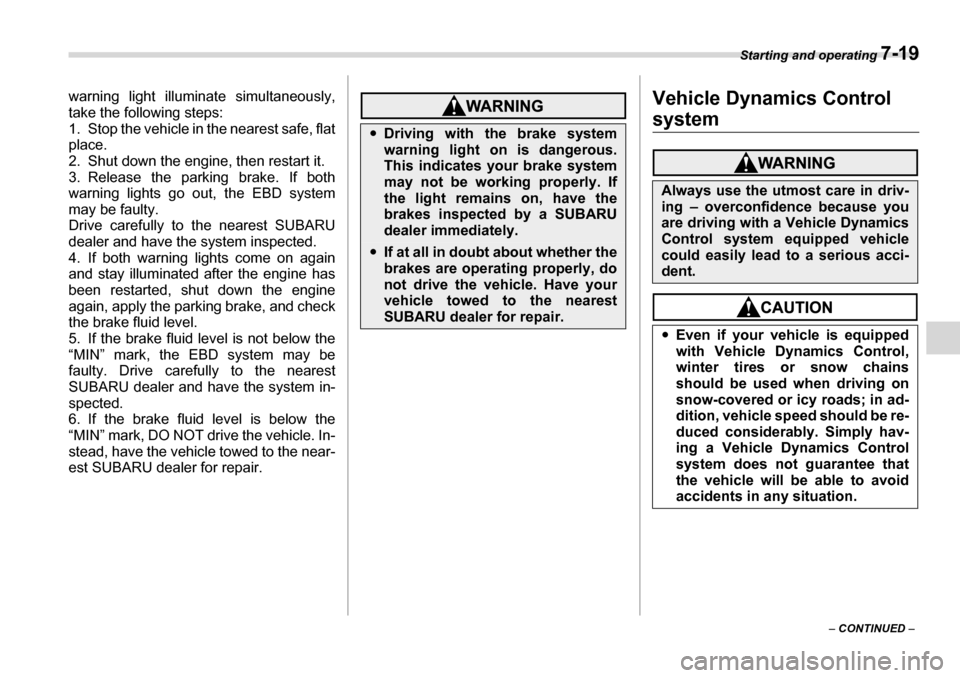
Starting and operating 7-19
– CONTINUED –
warning light illuminate simultaneously,
take the following steps:
1. Stop the vehicle in the nearest safe, flat
place.
2. Shut down the engine, then restart it.
3. Release the parking brake. If both
warning lights go out, the EBD system
may be faulty.
Drive carefully to the nearest SUBARU
dealer and have the system inspected.
4. If both warning lights come on again
and stay illuminated after the engine has
been restarted, shut down the engine
again, apply the parking brake, and check
the brake fluid level.
5. If the brake fluid level is not below the
“MIN” mark, the EBD system may be
faulty. Drive carefully to the nearest
SUBARU dealer and have the system in-
spected.
6. If the brake fluid level is below the
“MIN” mark, DO NOT drive the vehicle. In-
stead, have the vehicle towed to the near-
est SUBARU dealer for repair.
Vehicle Dynamics Control
system�y
Driving with the brake system
warning light on is dangerous.
This indicates your brake system
may not be working properly. If
the light remains on, have the
brakes inspected by a SUBARU
dealer immediately.
�yIf at all in doubt about whether the
brakes are operating properly, do
not drive the vehicle. Have your
vehicle towed to the nearest
SUBARU dealer for repair.
Always use the utmost care in driv-
ing – overconfidence because you
are driving with a Vehicle Dynamics
Control system equipped vehicle
could easily lead to a serious acci-
dent. �yEven if your vehicle is equipped
with Vehicle Dynamics Control,
winter tires or snow chains
should be used when driving on
snow-covered or icy roads; in ad-
dition, vehicle speed should be re-
duced considerably. Simply hav-
ing a Vehicle Dynamics Control
system does not guarantee that
the vehicle will be able to avoid
accidents in any situation.
Page 252 of 377
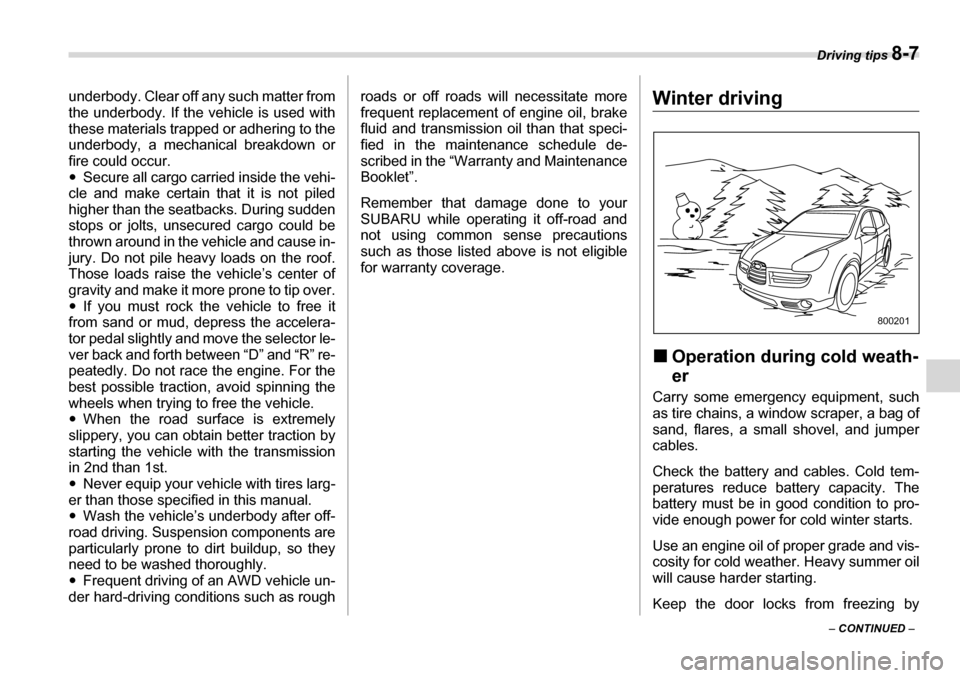
Driving tips 8-7
– CONTINUED –
underbody. Clear off any such matter from
the underbody. If the vehicle is used with
these materials trapped or adhering to the
underbody, a mechanical breakdown or
fire could occur. �y
Secure all cargo carried inside the vehi-
cle and make certain that it is not piled
higher than the seatbacks. During sudden
stops or jolts, unsecured cargo could be
thrown around in the vehicle and cause in-
jury. Do not pile heavy loads on the roof.
Those loads raise the vehicle’s center of
gravity and make it more prone to tip over. �y If you must rock the vehicle to free it
from sand or mud, depress the accelera-
tor pedal slightly and move the selector le-
ver back and forth between “D” and “R” re-
peatedly. Do not race the engine. For the
best possible traction, avoid spinning the
wheels when trying to free the vehicle. �y When the road surface is extremely
slippery, you can obtain better traction by
starting the vehicle with the transmission
in 2nd than 1st. �y Never equip your vehicle with tires larg-
er than those specified in this manual. �y Wash the vehicle’s underbody after off-
road driving. Suspension components are
particularly prone to dirt buildup, so they
need to be washed thoroughly. �y Frequent driving of an AWD vehicle un-
der hard-driving conditions such as rough roads or off roads will necessitate more
frequent replacement of engine oil, brake
fluid and transmission oil than that speci-
fied in the maintenance schedule de-
scribed in the “Warranty and Maintenance Booklet”.
Remember that damage done to your
SUBARU while operating it off-road and
not using common sense precautions
such as those listed above is not eligible for warranty coverage.
Winter driving �„
Operation during cold weath- er
Carry some emergency equipment, such
as tire chains, a window scraper, a bag of
sand, flares, a small shovel, and jumper cables.
Check the battery and cables. Cold tem-
peratures reduce battery capacity. The
battery must be in good condition to pro-
vide enough power for cold winter starts.
Use an engine oil of proper grade and vis-
cosity for cold weather. Heavy summer oil
will cause harder starting.
Keep the door locks from freezing by
800201